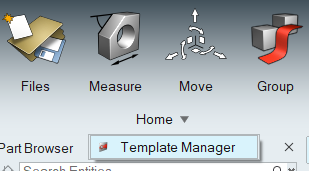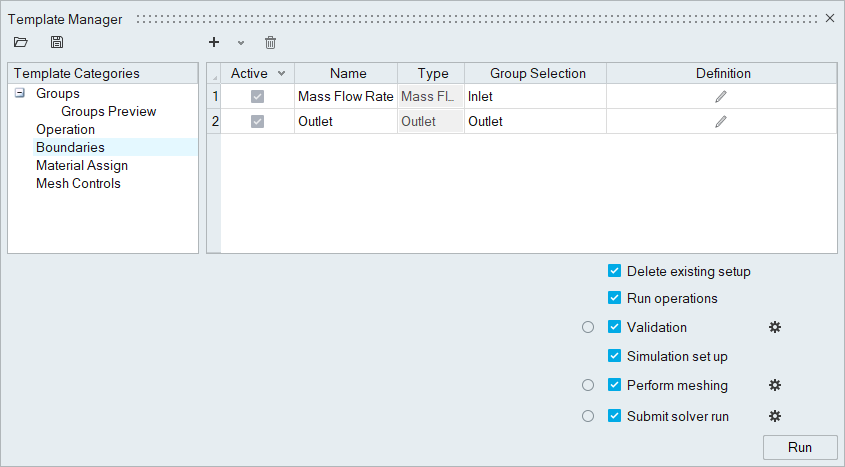Manage Automation Templates
Use the Template Manager to define rule-based logic for groups, geometric operations, and setup and automate simulation processes.
The Template Manager is useful for:
- Automating the simulation process – since templates are defined based on rules, they can be applied to other models which have the same attributes.
- Defining best practices for meshing and solver parameters and sharing with others
- Parametric studies
-
Click the arrow next to the Home tool set, then
select Template Manager.
Figure 1.

-
Create groups.
Groups allow you to define collections of parts, solids, surfaces, and lines based on rules.
- Click Groups under Template Categories.
-
Click
 to add a group.
to add a group.
- Give the group a name and select a geometry type.
-
Use the Definition drop-down and the Metadata Key/Value fields to
define the rules.
- By Parts Name
- Define full part names or use * to find parts with a partial name match (for example, part*).
- By Visibility
- Group based on visibility.
- Supported values are: All and Displayed
- By Metadata
- Define a metadata key and value.
- By Find and Select
- Group based on topological definition.
- Supported values are: Free surfaces, Internal surfaces, Intersecting surfaces, Baffles, Non-manifold surfaces, Sharp surfaces, Sliver surfaces, and Self-intersecting surfaces
- Use the Active checkboxes to select which groups you want to use.
These groups are referenced in the rest of the template categories for selection.
These groups are dynamic; they are evaluated while a specific instance of a category is being evaluated.Figure 2.
-
Define template instances.
- Click one of the setup options beneath Template Categories.
-
Click
 to add a new instance.
When there are multiple types of instances in a category like Inlet, Outlet, Wall – you can activate multiple instances at a time to create them all in one go.
to add a new instance.
When there are multiple types of instances in a category like Inlet, Outlet, Wall – you can activate multiple instances at a time to create them all in one go. - For boundaries and mesh controls, assign a name.
-
Define the instance and select the group it will act on. Click
 to edit
parameters.
to edit
parameters.
-
Use the Active checkboxes to select which instances you want to use.
Inactive instances will not be evaluated.
Figure 3.
-
Select the processes to be executed in sequence.
- Delete existing setup
- If on, the existing setup will be removed.
- Run operations
- If on, it will run the active instances defined in the Operation category.
- Validation
- If on, geometry validation will be performed after running operations or before performing setup, meshing, or solver run.
- Click
 to change the sliver
surface threshold used for validating sliver surfaces and sliver
solids.
to change the sliver
surface threshold used for validating sliver surfaces and sliver
solids. - If there are errors, they are highlighted with an exclamation icon. On clicking the icon, you can see a list of errors and update operations accordingly.
- Simulation set up
- If on, the process will check geometry validity and perform evaluation of active template instances.
- If geometry is not valid, it will terminate the process and update the geometry validation flag.
- Perform meshing
- If on, and the model is valid, the meshing job will be submitted.
- Click
 to define batch mesh
settings.
to define batch mesh
settings. - If geometry is not valid, it will terminate the process and update the geometry validation flag.
- Submit solver run
- If on, the process will check for model validity and the presence of volume mesh then submit the solver job.
- Click
 to define AcuSolve launch settings.
to define AcuSolve launch settings. - If volume mesh is not present, the solver job will not be submitted.
- Click Run.
Tip:
- Click
 to export a defined template
or
to export a defined template
or  to import a template.
to import a template. - To delete a group or template instance, select it and click
